‘This small-cap stock can become the next MULTIBAGGER!!!’
Many of us must have got mails with this headline some or the other time. And chances are that many of us must have also checked out which stock this is and invested in it! The first thing that catches our attention here is the word ‘MULTIBAGGER’. Who doesn’t want their money to multiply in a short time? Right? But, while there is a possibility that a few fortunate ones actually earn money from such multi-bagger ideas, there is also a possibility that your investment in the stock may be entirely wiped out.
The reason : Because while focusing on ‘MULTIBAGGER’, we ignored, possibly the more important word, i.e. ‘SMALL-CAP STOCK’!
Believe it or not, but the market capitalization of a stock plays an important role in deciding which stock you invest in. Choosing the best stock based on its market capitalization and your risk profile can help protect your hard-earned money and earn you great returns; more importantly it can prevent the heartburn you will get seeing your money go up in flames! But before we get into how you can do this, let’s first understand the basics of market capitalization.
So, what is market capitalization?
If you wish to buy a company and all its shares were offered to you at the current market price, how much would the company cost you?
The answer is its Market Capitalization. Yes, you will have to pay the “Market Capitalization” of the company which is the product of a company’s total number of shares outstanding and the market price of the share i.e.

Let’s understand it with the help of an example. Suppose, you decided to purchase ABC Industries on New Year, when its shares were trading at Rs.50 and the number of shares outstanding were 1 crore. You would have paid,
Rs.50 x 1,00,00,000 = Rs. 50,00,00,000
i.e., Rs. 50 Cr. is the Market Capitalization of ABC Industries.
However, what you should remember is that the market price of a share is the public opinion about the worth of a company’s stock. Thus, Market Capitalization is the public opinion of what the whole company is worth. This opinion is based on the past performance, future prospects and market sentiments of the public about the company. The market capitalization changes with time as a result of factors like company performance, economic factors like inflation, interest rates, etc. In India, you can find companies with market capitalization ranging from a few lakh to as much as few lakh crores! As a result, companies are usually classified as large-cap, mid-cap and small-cap companies. This brings us to the next question.
What are Large-cap, mid-cap and small-cap companies?
We have frequently heard about some companies being Large-cap (For e.g. Reliance, Infosys etc.) while others being Midcap or Small-cap companies. Wonder how they are classified? Let’s take a look at how the BSE classifies companies according to their market capitalization.
The 80-15-5 method:
BSE’s classifies companies according to their Market Capitalization by using the 80-15-5 method. Here’s how this method works:
- Arrange all the companies in descending order of their Market Capitalization.
- The group of companies from the top, which together contribute 80% of the total Market Capitalization are Large-cap Companies,
- The next group of companies contributing 15% (80-95%) of Market capitalization are Mid-cap companies, and
- The remaining companies which contribute 5% of Market Capitalization are Small-cap companies.
Thus, the Large-cap companies, Mid-cap companies and Small-cap companies contribute 80%, 15% and 5% of the total Market Capitalization of the market respectively. This is known as the 80-15-5 method. The number of small-cap companies is the highest followed by mid-cap and large-cap companies. Thus, a small proportion of the total number of companies (large-cap) contribute the major part (80%) of total market capitalization.
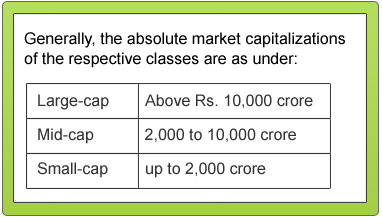
However, this does not mean that if the market falls or rises considerably, large-cap companies will become mid-cap and midcap will become small-cap, or vice-versa. Rather, the above ranges will change with a change in Total Market Capitalization.
So, what is the difference between these categories?
Market capitalization is regarded as an indicator of a company’s size. Large-cap companies are more robust. A large-cap company can be compared to a heavy goods carrier, while a midcap company to a mini carrier. If there is a speed breaker/bump on the road, the chances of a mini carrier getting knocked down are much more as compared to the heavy goods carrier. At the same time, a mini carrier picks up speed quickly and travels faster as compared to the heavy goods carrier; which requires time to catch up speed but has better stability and momentum. Given below is a comparative account of Large-cap, mid-cap and small-cap companies.
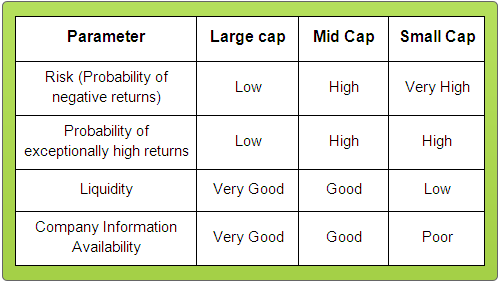
So, why should you as an investor look at a company’s market capitalization?
Let’s have a look at the Investor Meet where three good friends – Mr. Conservative, Mr. Practical and Mr. Adventurous are having dinner together:

What did u observe in the above picture?
Mr. Conservative has a very low risk appetite, so he wants to be safe and invests only in large-cap stocks.
Mr. Practical understands that if he wants high returns he must take high risk. So, he invests a part of his funds in Mid-cap stocks which increases his chance of getting a high return on his total investment. At the same time, he keeps a large part of his investment exposed to low risk by investing in large-cap stocks.
Mr. Adventurous, on the other hand, is willing to risk losing a large part of his investment, for the possibility of getting very high returns on his investments. So, he invests most of his funds in risky mid-cap and highly risky small-cap stocks; he keeps a very small part of his fund invested in large cap stocks.
Thus, market capitalization plays an important role in deciding which companies you should invest in considering your expected returns and your risk appetite.
So, what kind of person are you? Are you Mr. Conservative, Mr. Practical or Mr. Adventurous?
If you liked what you read and would like to put it in to practice Register at MoneyWorks4me.com. You will get amazing FREE features that will enable you to invest in Stocks and Mutual Funds the right way.
Need help on Investing? And more….Puchho Befikar
Kyunki yeh paise ka mamala hai
Start Chat | Request a Callback | Call 020 6725 8333 | WhatsApp 8055769463





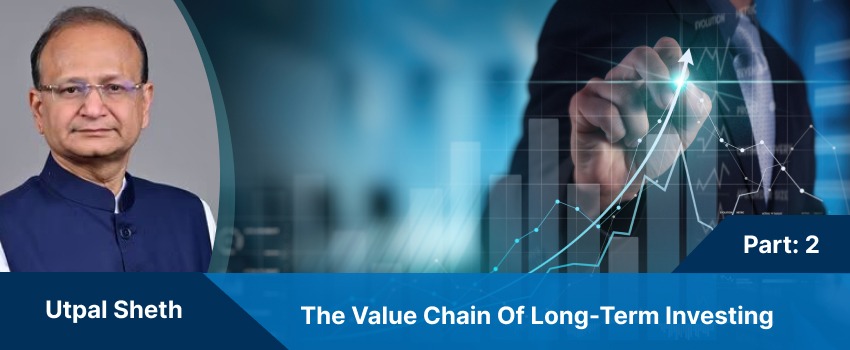
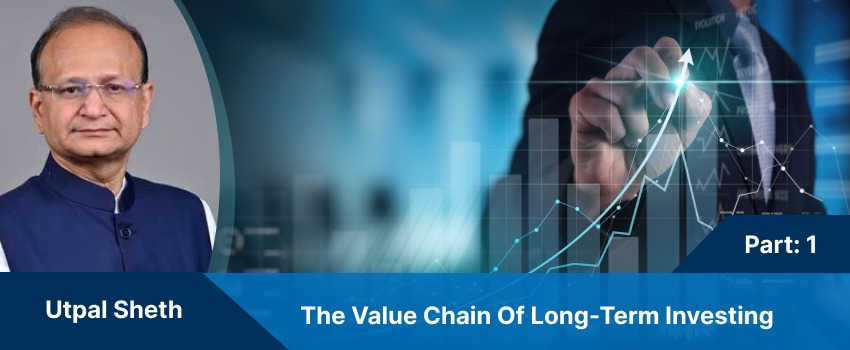


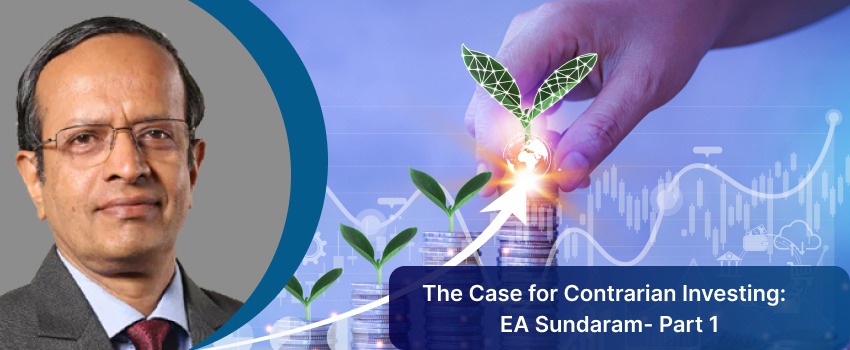

I learnt lot from your articles and most importantly the way you make it simple and understanding that ordinary person like me can understand it very well.
Hi Pernami2004,
Thanks for your appreciation. At MoneyWorks4me.com, it has been our constant endeavor to present knowledge in a simple, yet interesting manner without diluting it’s importance. Your appreciation is a motivation to us.
Keep reading and giving your feedback.
Happy investing.
Thanks for your appreciation. In the current market scenario, this classification becomes all the more important. With the markets crashing, investors can get opportunities to buy large cap companies at attractive prices.
Nice description. Thanks
Very informative and useful article.
In this tme what is a actual capitalization of large cap,Mid cap,small cap company,i above the mention data,i currect or not currect?
great article.. imp concept explained in simple and lucid manner
I am Mr. Practical 🙂
thanks
good one.. simple and easily understandable.. examples are very good
Very simply put. Thank you.
Excellent presentation. Now, I believe, I can understand these essential information about stocks. Thank you.
excellent article……..
Plz tell me how to check that a company belongs to which mcap(large,mid,small)???
thanx vry
much for such a discription
I learnt lot from your articles. Thanx for this topic and I m a prectical person.
thx for this simple article, easy understandab
le.
Nicely explained
Simple yet powerful for new bee
Very well explained in the simplest manner…
Good work
please keep sharing
The large cap companies are also one of the best in terms of paying dividends regularly. Therefore, people who are looking for regular income in the form of dividends with least amount of risk should invest in large caps with sound fundamentals. One can go through the article Top 5 companies with highest dividend yield “http://www.adityagreens.com/entries/finance-investing/top-5-indian-blue-chip-companies-with-highest-dividend-yield-” in http://www.adityagreens.com
Very useful article with lucid presentation … good work …
Amazingly explained. I am a finance professional, and read many books related to market cap; including books for CA-final and PGDFM, and yet, I found this article most useful. Simplicity and clarity, and conviction of author is extremely admirable. Keep it up ! A big thumps up !!!
Great information. I wandering all over the net but found the real answer at your blog.
Keep the thing up.
Regards
http://sowmayjain.com